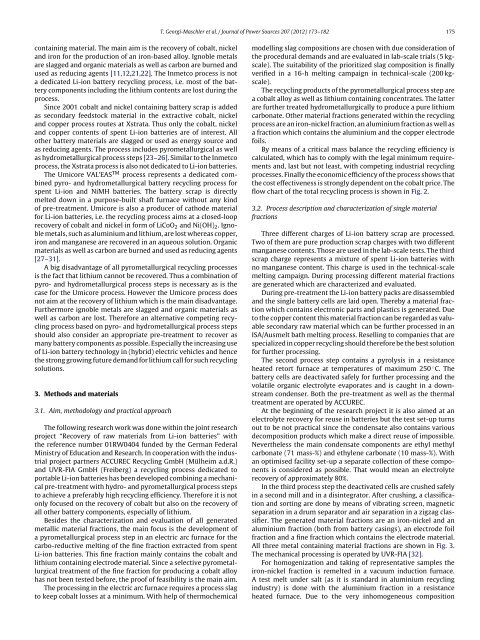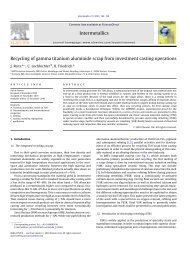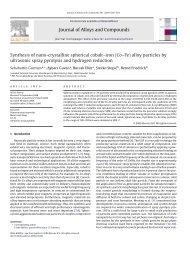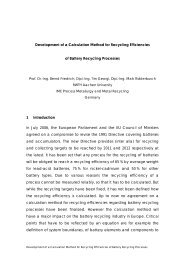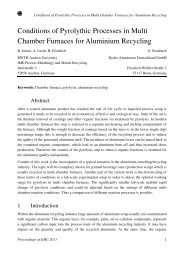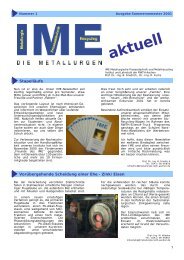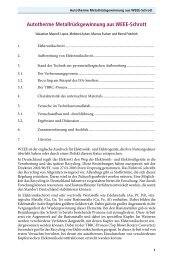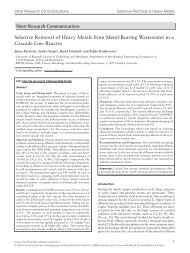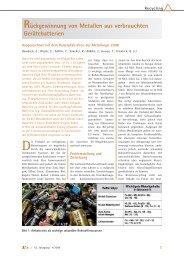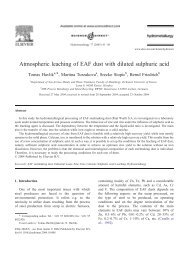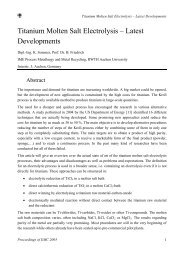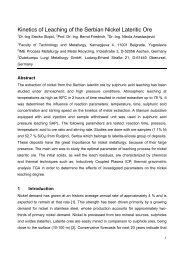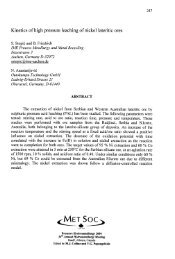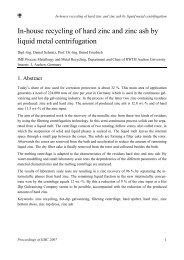Development of a recycling process for Li-ion batteries
Development of a recycling process for Li-ion batteries
Development of a recycling process for Li-ion batteries
- No tags were found...
Create successful ePaper yourself
Turn your PDF publications into a flip-book with our unique Google optimized e-Paper software.
T. Georgi-Maschler et al. / Journal <strong>of</strong> Power Sources 207 (2012) 173–182 175<br />
containing material. The main aim is the recovery <strong>of</strong> cobalt, nickel<br />
and iron <strong>for</strong> the product<strong>ion</strong> <strong>of</strong> an iron-based alloy. Ignoble metals<br />
are slagged and organic materials as well as carbon are burned and<br />
used as reducing agents [11,12,21,22]. The Inmetco <strong>process</strong> is not<br />
a dedicated <strong>Li</strong>-<strong>ion</strong> battery <strong>recycling</strong> <strong>process</strong>, i.e. most <strong>of</strong> the battery<br />
components including the lithium contents are lost during the<br />
<strong>process</strong>.<br />
Since 2001 cobalt and nickel containing battery scrap is added<br />
as secondary feedstock material in the extractive cobalt, nickel<br />
and copper <strong>process</strong> routes at Xstrata. Thus only the cobalt, nickel<br />
and copper contents <strong>of</strong> spent <strong>Li</strong>-<strong>ion</strong> <strong>batteries</strong> are <strong>of</strong> interest. All<br />
other battery materials are slagged or used as energy source and<br />
as reducing agents. The <strong>process</strong> includes pyrometallurgical as well<br />
as hydrometallurgical <strong>process</strong> steps [23–26]. Similar to the Inmetco<br />
<strong>process</strong>, the Xstrata <strong>process</strong> is also not dedicated to <strong>Li</strong>-<strong>ion</strong> <strong>batteries</strong>.<br />
The Umicore VAL’EAS TM <strong>process</strong> represents a dedicated combined<br />
pyro- and hydrometallurgical battery <strong>recycling</strong> <strong>process</strong> <strong>for</strong><br />
spent <strong>Li</strong>-<strong>ion</strong> and NiMH <strong>batteries</strong>. The battery scrap is directly<br />
melted down in a purpose-built shaft furnace without any kind<br />
<strong>of</strong> pre-treatment. Umicore is also a producer <strong>of</strong> cathode material<br />
<strong>for</strong> <strong>Li</strong>-<strong>ion</strong> <strong>batteries</strong>, i.e. the <strong>recycling</strong> <strong>process</strong> aims at a closed-loop<br />
recovery <strong>of</strong> cobalt and nickel in <strong>for</strong>m <strong>of</strong> <strong>Li</strong>CoO 2 and Ni(OH) 2 . Ignoble<br />
metals, such as aluminium and lithium, are lost whereas copper,<br />
iron and manganese are recovered in an aqueous solut<strong>ion</strong>. Organic<br />
materials as well as carbon are burned and used as reducing agents<br />
[27–31].<br />
A big disadvantage <strong>of</strong> all pyrometallurgical <strong>recycling</strong> <strong>process</strong>es<br />
is the fact that lithium cannot be recovered. Thus a combinat<strong>ion</strong> <strong>of</strong><br />
pyro- and hydrometallurgical <strong>process</strong> steps is necessary as is the<br />
case <strong>for</strong> the Umicore <strong>process</strong>. However the Umicore <strong>process</strong> does<br />
not aim at the recovery <strong>of</strong> lithium which is the main disadvantage.<br />
Furthermore ignoble metals are slagged and organic materials as<br />
well as carbon are lost. There<strong>for</strong>e an alternative competing <strong>recycling</strong><br />
<strong>process</strong> based on pyro- and hydrometallurgical <strong>process</strong> steps<br />
should also consider an appropriate pre-treatment to recover as<br />
many battery components as possible. Especially the increasing use<br />
<strong>of</strong> <strong>Li</strong>-<strong>ion</strong> battery technology in (hybrid) electric vehicles and hence<br />
the strong growing future demand <strong>for</strong> lithium call <strong>for</strong> such <strong>recycling</strong><br />
solut<strong>ion</strong>s.<br />
3. Methods and materials<br />
3.1. Aim, methodology and practical approach<br />
The following research work was done within the joint research<br />
project “Recovery <strong>of</strong> raw materials from <strong>Li</strong>-<strong>ion</strong> <strong>batteries</strong>” with<br />
the reference number 01RW0404 funded by the German Federal<br />
Ministry <strong>of</strong> Educat<strong>ion</strong> and Research. In cooperat<strong>ion</strong> with the industrial<br />
project partners ACCUREC Recycling GmbH (Mülheim a.d.R.)<br />
and UVR-FIA GmbH (Freiberg) a <strong>recycling</strong> <strong>process</strong> dedicated to<br />
portable <strong>Li</strong>-<strong>ion</strong> <strong>batteries</strong> has been developed combining a mechanical<br />
pre-treatment with hydro- and pyrometallurgical <strong>process</strong> steps<br />
to achieve a preferably high <strong>recycling</strong> efficiency. There<strong>for</strong>e it is not<br />
only focused on the recovery <strong>of</strong> cobalt but also on the recovery <strong>of</strong><br />
all other battery components, especially <strong>of</strong> lithium.<br />
Besides the characterizat<strong>ion</strong> and evaluat<strong>ion</strong> <strong>of</strong> all generated<br />
metallic material fract<strong>ion</strong>s, the main focus is the development <strong>of</strong><br />
a pyrometallurgical <strong>process</strong> step in an electric arc furnace <strong>for</strong> the<br />
carbo-reductive melting <strong>of</strong> the fine fract<strong>ion</strong> extracted from spent<br />
<strong>Li</strong>-<strong>ion</strong> <strong>batteries</strong>. This fine fract<strong>ion</strong> mainly contains the cobalt and<br />
lithium containing electrode material. Since a selective pyrometallurgical<br />
treatment <strong>of</strong> the fine fract<strong>ion</strong> <strong>for</strong> producing a cobalt alloy<br />
has not been tested be<strong>for</strong>e, the pro<strong>of</strong> <strong>of</strong> feasibility is the main aim.<br />
The <strong>process</strong>ing in the electric arc furnace requires a <strong>process</strong> slag<br />
to keep cobalt losses at a minimum. With help <strong>of</strong> thermochemical<br />
modelling slag composit<strong>ion</strong>s are chosen with due considerat<strong>ion</strong> <strong>of</strong><br />
the procedural demands and are evaluated in lab-scale trials (5 kgscale).<br />
The suitability <strong>of</strong> the prioritized slag composit<strong>ion</strong> is finally<br />
verified in a 16-h melting campaign in technical-scale (200 kgscale).<br />
The <strong>recycling</strong> products <strong>of</strong> the pyrometallurgical <strong>process</strong> step are<br />
a cobalt alloy as well as lithium containing concentrates. The latter<br />
are further treated hydrometallurgically to produce a pure lithium<br />
carbonate. Other material fract<strong>ion</strong>s generated within the <strong>recycling</strong><br />
<strong>process</strong> are an iron-nickel fract<strong>ion</strong>, an aluminium fract<strong>ion</strong> as well as<br />
a fract<strong>ion</strong> which contains the aluminium and the copper electrode<br />
foils.<br />
By means <strong>of</strong> a critical mass balance the <strong>recycling</strong> efficiency is<br />
calculated, which has to comply with the legal minimum requirements<br />
and, last but not least, with competing industrial <strong>recycling</strong><br />
<strong>process</strong>es. Finally the economic efficiency <strong>of</strong> the <strong>process</strong> shows that<br />
the cost effectiveness is strongly dependent on the cobalt price. The<br />
flow chart <strong>of</strong> the total <strong>recycling</strong> <strong>process</strong> is shown in Fig. 2.<br />
3.2. Process descript<strong>ion</strong> and characterizat<strong>ion</strong> <strong>of</strong> single material<br />
fract<strong>ion</strong>s<br />
Three different charges <strong>of</strong> <strong>Li</strong>-<strong>ion</strong> battery scrap are <strong>process</strong>ed.<br />
Two <strong>of</strong> them are pure product<strong>ion</strong> scrap charges with two different<br />
manganese contents. Those are used in the lab-scale tests. The third<br />
scrap charge represents a mixture <strong>of</strong> spent <strong>Li</strong>-<strong>ion</strong> <strong>batteries</strong> with<br />
no manganese content. This charge is used in the technical-scale<br />
melting campaign. During <strong>process</strong>ing different material fract<strong>ion</strong>s<br />
are generated which are characterized and evaluated.<br />
During pre-treatment the <strong>Li</strong>-<strong>ion</strong> battery packs are disassembled<br />
and the single battery cells are laid open. Thereby a material fract<strong>ion</strong><br />
which contains electronic parts and plastics is generated. Due<br />
to the copper content this material fract<strong>ion</strong> can be regarded as valuable<br />
secondary raw material which can be further <strong>process</strong>ed in an<br />
ISA/Ausmelt bath melting <strong>process</strong>. Reselling to companies that are<br />
specialized in copper <strong>recycling</strong> should there<strong>for</strong>e be the best solut<strong>ion</strong><br />
<strong>for</strong> further <strong>process</strong>ing.<br />
The second <strong>process</strong> step contains a pyrolysis in a resistance<br />
heated retort furnace at temperatures <strong>of</strong> maximum 250 ◦ C. The<br />
battery cells are deactivated safely <strong>for</strong> further <strong>process</strong>ing and the<br />
volatile organic electrolyte evaporates and is caught in a downstream<br />
condenser. Both the pre-treatment as well as the thermal<br />
treatment are operated by ACCUREC.<br />
At the beginning <strong>of</strong> the research project it is also aimed at an<br />
electrolyte recovery <strong>for</strong> reuse in <strong>batteries</strong> but the test set-up turns<br />
out to be not practical since the condensate also contains various<br />
decomposit<strong>ion</strong> products which make a direct reuse <strong>of</strong> impossible.<br />
Nevertheless the main condensate components are ethyl methyl<br />
carbonate (71 mass-%) and ethylene carbonate (10 mass-%). With<br />
an optimised facility set-up a separate collect<strong>ion</strong> <strong>of</strong> these components<br />
is considered as possible. That would mean an electrolyte<br />
recovery <strong>of</strong> approximately 80%.<br />
In the third <strong>process</strong> step the deactivated cells are crushed safely<br />
in a second mill and in a disintegrator. After crushing, a classificat<strong>ion</strong><br />
and sorting are done by means <strong>of</strong> vibrating screen, magnetic<br />
separat<strong>ion</strong> in a drum separator and air separat<strong>ion</strong> in a zigzag classifier.<br />
The generated material fract<strong>ion</strong>s are an iron-nickel and an<br />
aluminium fract<strong>ion</strong> (both from battery casings), an electrode foil<br />
fract<strong>ion</strong> and a fine fract<strong>ion</strong> which contains the electrode material.<br />
All three metal containing material fract<strong>ion</strong>s are shown in Fig. 3.<br />
The mechanical <strong>process</strong>ing is operated by UVR-FIA [32].<br />
For homogenizat<strong>ion</strong> and taking <strong>of</strong> representative samples the<br />
iron-nickel fract<strong>ion</strong> is remelted in a vacuum induct<strong>ion</strong> furnace.<br />
A test melt under salt (as it is standard in aluminium <strong>recycling</strong><br />
industry) is done with the aluminium fract<strong>ion</strong> in a resistance<br />
heated furnace. Due to the very inhomogeneous composit<strong>ion</strong>


